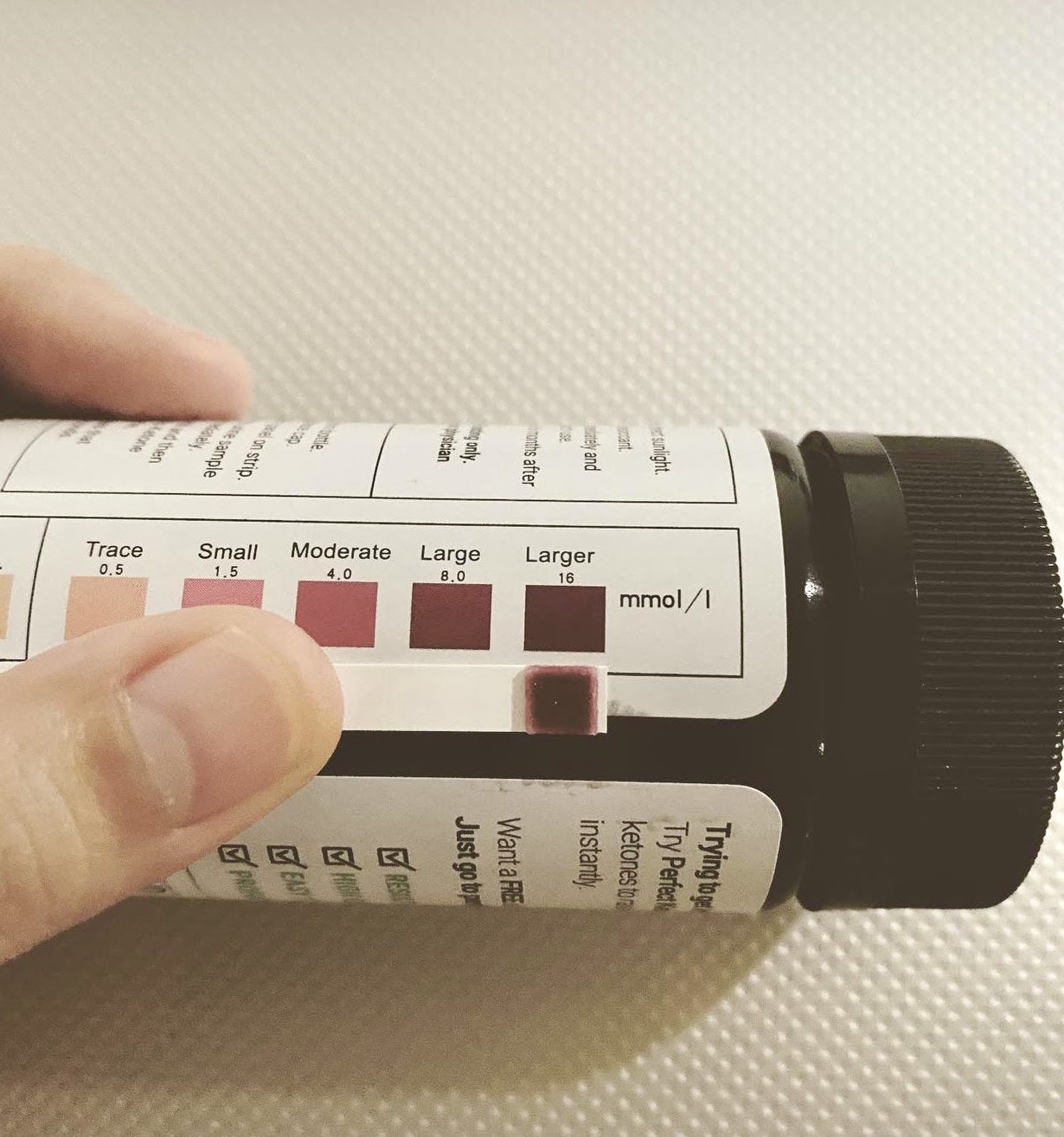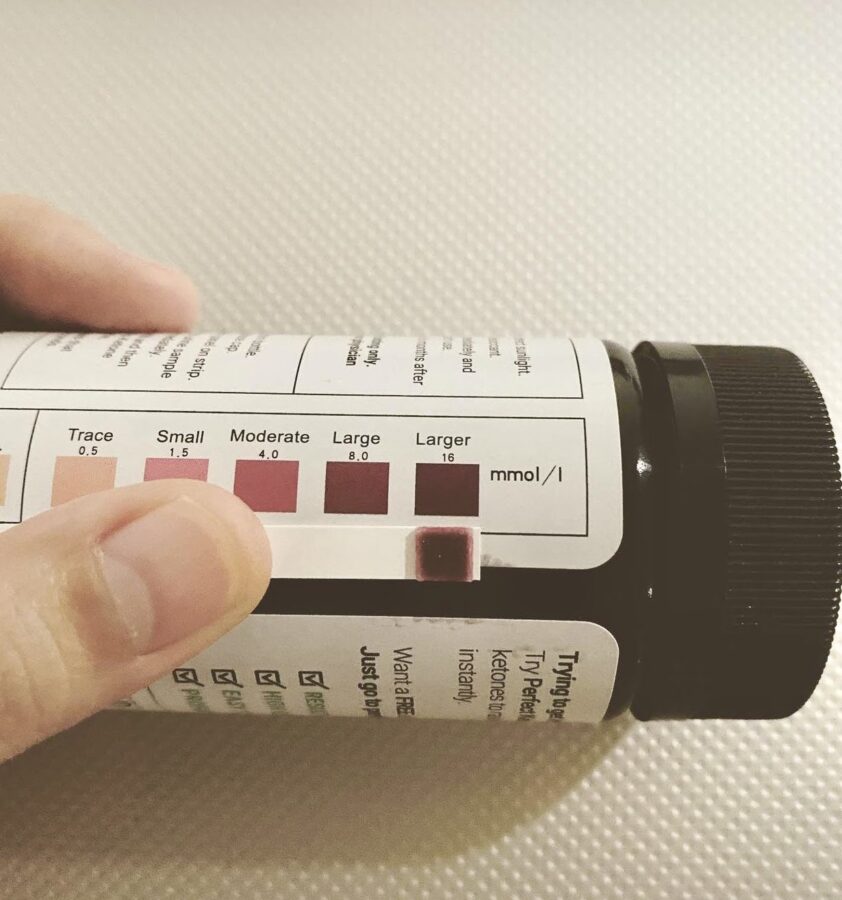
The main goal of following a very low-carb keto diet is to enter a fat-burning state called ketosis, which leads to weight loss and other health benefits.
However, it can be difficult to tell whether you’re really in ketosis or not unless you use some form of objective feedback. Thankfully, there are various ways to test, and one convenient way of doing so is through urine ketone testing strips.
This guide discusses urine ketone strips — how they work, what the test results mean, other ways to test, diabetic ketoacidosis, and ways to achieve optimal ketone levels.
What Are Ketone Test Strips? And How To Use Them
Ketone test strips are made from a type of paper that changes color as it reacts with your urine. They measure acetoacetate (AcAc), the second most abundant ketone which your body excretes through urine.
Urine testing is non-invasive and the most convenient ketosis testing method that provides results in seconds. If you test daily, you can do it in the morning or evening, preferably at the same hour.
Although ketone test strips are not a must on the ketogenic diet, they can be highly beneficial to those just starting keto. It allows you to stay accountable and make a connection between your food, ketone levels, and how you’re actually feeling on a certain level of ketosis.
And if you find yourself trying to get back into ketosis after having a cheat day or diet break for a week or more, then test strips are also helpful for those situations.
How To Use Urine Test Strips On A Low-Carb Diet:
Step 1: Wash your hands.
Step 2: Pee in a small, clean container, then dip the test end of the strip into the urine sample. Alternatively, you can pass the end of the strip briefly through your urine stream.
Step 3: Wait for a few seconds (or as indicated on the test package) for the end of the strip to change color.
Step 4: Compare the color with the color chart on the test package. (Proceed to the next section of this article to learn more about what your test results mean.)
Step 5: Discard the urine testing strip. Then wash your hands.
How To Interpret Ketosis Urine Strip Results
Urine keto test strips have a light beige color, which darkens with high levels of ketones. The deeper the color turns out to be, the more ketone bodies are detected in your urine.
Here’s a color chart that serves as a reference for different ketone levels and what they mean:
- Negative (no ketones): You are not in ketosis at all
- Trace (0.5 mmol/L): This means light nutritional ketosis
- Small (1.5 mmol/L): This means light nutritional ketosis
- Moderate (4.0 mmol/L): Ketones increase further as a result of exercise or fasting
- Large (8.0 mmol/L): Usually a result of prolonged fasting, not sustainable in the long-term (*).
- Larger (16 mmol/L): Usually a result of prolonged fasting, not sustainable in the long-term (*).
Note: mmol/L stands for millimoles per liter, and it refers to the concentration of ketones in a specific amount of liquid — in this case, your urine.
The optimum level for ketosis falls between 0.5 and 2 mmol/L due to following a well-formulated ketogenic diet (*).
But, as you can see from the interpretations above, higher ketones aren’t necessarily better for everyone. While high ketone levels (5 mmol/L and above) can lead to more significant weight loss, this may eventually result in nutrient deprivation and a loss of muscle mass (*).
To demonstrate, the author of this article shared her ketone level below (as part of a personal experiment, using Perfect Keto’s test strips) after bringing down carbs to zero and consuming lower than usual amounts of protein (around 70 grams per day for 3 days):

According to the author, when comparing lighter to deeper levels of nutritional ketosis, she felt more energized, focused, and able to work out on the level of light to moderate nutritional ketosis but not with deeper ketosis.
If you’re following the low-carb, high-fat keto diet to attain weight loss and improve metabolic health in general, ketone levels above the optimum range (0.5 and 2 mmol/L) would be unnecessary unless prescribed by your healthcare provider for medical reasons. Potential reasons for higher target levels include ketosis as a tool for diabetes or blood pressure management.
Other Factors That Affect Urine Ketone Test Results
In some cases, your ketone levels may decrease or increase despite your being consistent with your keto diet. Here are a couple of reasons this tends to occur:
- Adaptation (resulting in decreased ketone levels). As you maintain a ketogenic lifestyle, your body adapts, and with that, it becomes more effective in utilizing ketones as its fuel source. Meaning, ketones are less likely to spill over into your urine. You might actually be at a deeper level of ketosis but it doesn’t show in your test results.
- Dehydration (resulting in increased ketone levels). One randomized controlled trial found a direct proportion between serum ketone concentration and the level of dehydration. The more dehydrated a subject was, the higher their ketone levels (*).
. Ensuring good hydration when testing for ketones helps produce more accurate and consistent results. - Expired test strips (may result in undetectable ketones). Check the expiration date of your urine test strips. Strips usually expire within 3-6 months after you open the sealed bottle container. Last but not least, store the bottle in a cool, dark place, away from direct sunlight to preserve their quality.
High Ketone Levels May Indicate Diabetic Ketoacidosis
Now that you know what your ketone levels should be as a result of following a keto diet, we need to tackle an important topic: diabetic ketoacidosis.
It’s important not to confuse ketosis with ketoacidosis, a serious complication that may occur in poorly managed Type 1 Diabetes and, more rarely, Type 2 Diabetes and is characterized by abnormally high ketone concentrations of over 20 mmol/L (*).
Blood sugar levels tend to be unusually high as well, exceeding 250 mg/dL (*).
The good news: as long as your keto diet is well-formulated, it definitely won’t lead to ketoacidosis. Meaning, you adhere to the right macro ratios, meet your electrolyte needs, don’t restrict calories, and get healthcare supervision if you’re using keto to manage or reverse a condition like diabetes or high blood pressure (*).
The bottom line is that while people sometimes confuse healthy nutritional ketosis with diabetic ketoacidosis, one does not lead to another. And for anyone with diabetes who is concerned about ketoacidosis, urine test strips are actually a helpful tool to ensure you’re not in ketoacidosis (whether or not you follow the keto diet).
Three Other Ways To Test For Ketosis
Ketones show up not just in your urine but also in your blood and breath. Below, we explore the following ways to test for ketosis — blood ketone testing and breath ketone testing — and some of their pros and cons.
Blood Ketone Meter
This testing method measures blood ketone levels of beta-hydroxybutyrate (BHB), the most abundant ketone body. It’s the most accurate way to confirm that you’re in ketosis, especially when you’ve been doing keto for quite a while now.
However, the downside is that a ketone blood test is more expensive, not to mention more invasive. You’ll have to prick your finger using a lancet to get a small blood sample, place it on the test strip attached to a blood ketone meter, and wait for the result.
Blood ketone testing isn’t for you if you’re scared of drawing blood or find it bothersome. But in case you opt for this, a ketone meter like Keto-Mojo is great for reading both your ketone and blood glucose levels (handy especially for a person with diabetes).
Breath Analyzer
Measuring ketosis can also be done using a handheld device called a breath meter or analyzer. Again, no test strips are required for this, and you simply have to blow into the tube attached to the device to get a quick reading.
What does this measure? Acetone (Ace), the third and least abundant ketone that’s released via your breath.
Like urine testing, breath testing is affordable, though it has the disadvantage of being less accurate. Yet, if you’re new to keto and want a non-invasive and convenient way to test regardless of the place and time, breath testing is a practical option.
Lab Testing
Lab testing is the most expensive and highly accurate way to measure ketones in your serum or plasma (from your venous blood sample). It’s usually ordered by a healthcare provider to closely monitor diabetic ketoacidosis in emergency room patients.
As a keto dieter, this ketone monitoring method isn’t practical because you can’t go to a lab or doctor’s office every day. Home ketone meter kits and urine strips can already provide good results as long as you follow the instructions specified on the testing kit.
What To Expect During Ketosis
When you restrict carbohydrates in your diet, your body finds an alternate fuel source, so it breaks down its own stored fat to make ketones (BHB, AcAc, and Ace).
Being in a state of ketosis can manifest signs and symptoms like weight loss (usually water weight), bad breath, low energy, frequent urination, irritability, and digestive issues.
Such effects subside once your body gets used to using ketones for fuel, and then you’ll experience sustained fat loss, reduced cravings, more stable energy, and increased mental clarity.
While these are all suggestive of nutritional ketosis, the best way to tell is by testing with Perfect Keto’s urine ketone test strips or a blood or breath ketone meter of your choice.
How To Achieve Optimal Ketone Levels
To enter ketosis and reach an optimal ketone level of 0.5 and 2 mmol/L, you must limit your dietary carbohydrates to 30-50 grams (or lower than that) per day. Doing this will deplete your stored glycogen and force your body to start burning fatty acids and forming ketones.
At the same time, you should also be eating more healthful fats to curb your hunger and support your hormones, and moderate amounts of protein for cell repair and growth.
Intermittent fasting and exercising are also effective ways to enter ketosis sooner, on top of starting a well-formulated keto diet or doing a keto reset (if you’ve been off the diet for a while).
Overall, monitoring your carbohydrate intake helps you keep your diet on track while dialing in other macros is helpful for optimizing your results.
As long as you’re consistent, the result will be nutritional ketosis, and you can use urine strips to confirm that you’re on the right track.
Conclusion
If you are following a very low-carb ketogenic diet, there’s no easier way of knowing whether you’re in ketosis than using ketone strips. They’re affordable and perfect for new keto dieters as well as those who have taken a break from the diet and want to return to ketosis.
For optimal ketosis, ketone levels of 0.5-2 mmol/L are a good range for weight loss and overall health. However, going beyond this range often isn’t sustainable or necessary (unless prescribed and closely supervised by your healthcare provider for medical reasons).
That’s everything you need to know about testing your urine for ketosis. Ready to give it a try? Holding yourself accountable becomes a lot easier with quality ketone strips at your disposal.
8 References
Discover more from reviewer4you.com
Subscribe to get the latest posts to your email.




